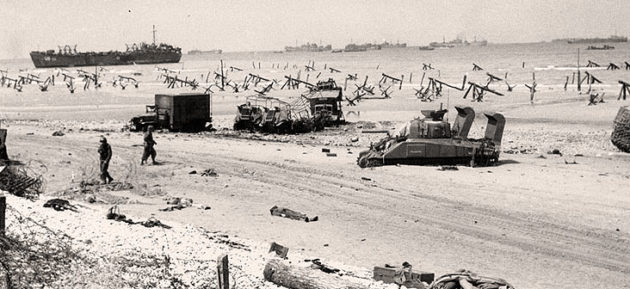Omaha Beach, afternoon of June 6, 1944. In the background are examples of the beach obstacles which confronted the men of GAT-10. The wooden poles frequently had German Teller mines wired to them intended to impale and then detonate on the hulls of landing craft. Just forward of the poles are a few steel Czech hedgehogs. Courtesy of U.S. Navy, National Archives
During the invasion of Normandy, France, on June 6, 1944, a select number of Civil Engineer Corps (CEC) officers and Seabees in Naval Combat Demolition Units (NCDUs) numbered among the first Americans ashore to clear the beaches for the ensuing infantry assault. One of these CEC officers, 28-year-old reservist, Ensign Lawrence Stephen Karnowski, Tampa, Kan., would be awarded the Navy Cross for his valor that day amid the bloodstained sands of Omaha Beach.
In early 1944, as part of Hitler’s Atlantic Wall defenses, German Field Marshal Erwin Rommel ordered the placement of countless beach obstacles along the French coast to prevent landing craft and tanks from safely coming ashore. These obstacles ranged from steel tetrahedrons (dubbed “Czech hedgehogs”), to wooden posts with landmines attached, to large steel fences affectionately called “Belgian Gates.” All could destroy the hulls of landing craft or block entryways onto the beach. The Allied invasion could not succeed without first clearing the beaches of these obstacles, minimizing the exposure of infantry from debarkation to reaching defilade. Mechanical means of obstacle clearance proved inadequate. The only other alternative was to use men trained in demolitions to clear obstacles by hand while under fire.
By Dr. Frank Blazich, Jr., Historian, U.S. Navy Seabee Museum


Leave a Reply
You must be logged in to post a comment.